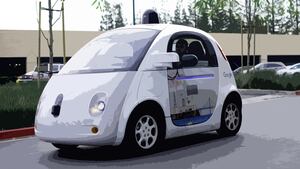Technological innovations are often initially met with puzzlement. When personal computers were first widely marketed to the public in the 1980s, some people couldn’t imagine why they would buy one. Who would need to do math at home? It’s not until that technology has infused itself into our daily existence that we can suddenly see with high-definition clarity how it transformed everything.
We’re not there yet with autonomous vehicles. They’ll change our lives, we’re told, but it’s hard to picture how, beyond allowing us to scroll through our Instagram feeds while a robot drives us to work.
The Road Ahead: Reimagining Mobility, a sleek new exhibit on view through March at New York City’s Cooper Hewitt, Smithsonian Design Museum, brings this future into sharper focus.
The potential of AVs to flip our urban world upside down is vividly depicted. In an all-AV city, car ownership is obsolete—fleets of self-driving vehicles pick you up and drop you off. This Uber-minus-the-drivers universe eliminates our most wasteful use of city streets, parked cars, the space reclaimed from which can be reserved for self-driving delivery vehicles.
Many of these vehicles will be miniaturized—think cooler-sized bots toting Amazon Pantry products—and will become a familiar sight zipping past us in their own dedicated lanes.
In fact, streets, sidewalks, buildings and traffic patterns will all be redesigned to accommodate vehicles that sense our presence, respond to our commands and follow us around.
The exhibit’s renderings show streets entirely reconfigured to accommodate self-driving food trucks, transit vehicles, personal robots, and wheelchair-accessible AV pods. Driverless electric buses recharge at every stop via a wireless charging pad built into the road beneath them. Mobile medical units resemble Popemobiles equipped with blood-pressure cuffs.
Autonomous vehicles aren’t the only focus of Cooper Hewitt’s exhibit, which offers a broad look at the future of mobility. But perhaps inevitably, they’re the star of the show.
This speaks to the conundrum AVs represent. Our cities are built all wrong largely because they’re designed around the personal vehicle—two-ton machines carrying a single 180-pound passenger. Which begs the question: As tech giants in Palo Alto conspire with carmakers in Detroit to map out our urban future, are we effectively doubling down on the biggest mistake of 20th century urbanism?
Proponents of AV-oriented cities argue that the problem isn’t cars themselves, it’s the bad things cars do: pollute the air, create congestion, kill lots of people. Safer, smarter, cleaner autonomous vehicles promise to resolve many of these issues. Nevertheless, committing to them is a very different approach than the goal of getting cars out of cities.
That goal has been around for almost as long as cars themselves. A 1924 New York Times op-ed lamented the “never heeding, never ending train of automobiles”overrunning city streets. In Annie Hall, released 41 years ago, Woody Allen says all cars should be banned from Manhattan.
More recently, Michael Bloomberg and his transportation commissioner, Janette Sadik-Khan, led an apologetically anti-car charge, pedestrianizing large swathes of New York and swapping out parking spaces for bike lanes.
Cities from Milwaukee to Portland have torn down major freeways, while congestion pricing has successfully cut down on car use in London and Singapore.
Now, just as some European cities are banning cars from their urban cores entirely, AV proponents are challenging the very notion that fewer cars is necessarily better. Some have even wondered whether flooding cities with enough self-driving cars could eliminate the need for mass transit altogether.
Elon Musk himself, godfather of the transportation moonshot (both literally and figuratively), has endorsed the idea that transit should “take people all the way to their destination,” which sounds a lot like what cars do.
Already, those kinds of fantasies are killing off transit initiatives. One Bay Area city recently voted down dedicated bus lanes because, as a city council member put it, “When cars are actually autonomous and speak to each other, they will be packed more densely on the roads, and they won’t be creating that congestion. So the idea of spending huge amounts of money on concrete to do this, it’s not a futuristic 21st century idea, it’s actually a very 20th century idea.”
Yet most urban planners will tell you that no amount of automation can make cars a viable transportation option in cities—the geometry simply doesn’t pencil out.
Jarrett Walker, author of the blog Human Transit, has spoken often about this. “So a bus with 40 people on it today is blown apart into, what, little driverless vans with an average of two each, a 20-fold increase in the number of vehicles?” he writes. “It doesn’t matter if they’re electric or driverless. Where will they all fit in the urban street? And when they take over, what room will be left for wider sidewalks, bike lanes, pocket parks, or indeed anything but a vast river of vehicles?”
The Cooper Hewitt exhibit engages with this disconnect, with diagrams showing how many more passengers can be moved with transit than with cars.
But it can be tough to hold people’s attention with such details. The exhibit’s most visually exciting components are things like a CGI video that shows how a driverless car senses objects around it, and a model that depicts how AVs might communicate with pedestrians using LED signage.
Even driverless buses—which the exhibit features, and which could be a boon to mass transit—don’t seem quite as fun as the idea of personal pods that zip us from door to door.
In the end, lots of innovative transportation turns out to be ill-conceived. (There was a time when urban freeways were seen as a pinnacle of forward-thinking infrastructure.) And yet, we return to it over and over, perhaps because maintaining and upgrading the same old mass transit we’ve been using for a hundred years isn’t as fun as reimagining mobility.
The problem with this is that once you’ve allowed your buses and trains to degrade to a breaking point, you’ve got little to lose, and putting your faith back in cars—smarter cars, better cars —seems like a risk worth taking.
The Road Ahead: Reimagining Mobility is at the Cooper Hewitt, Smithsonian Design Museum, 2 East 91st Street, NYC, until March 31, 2019.






